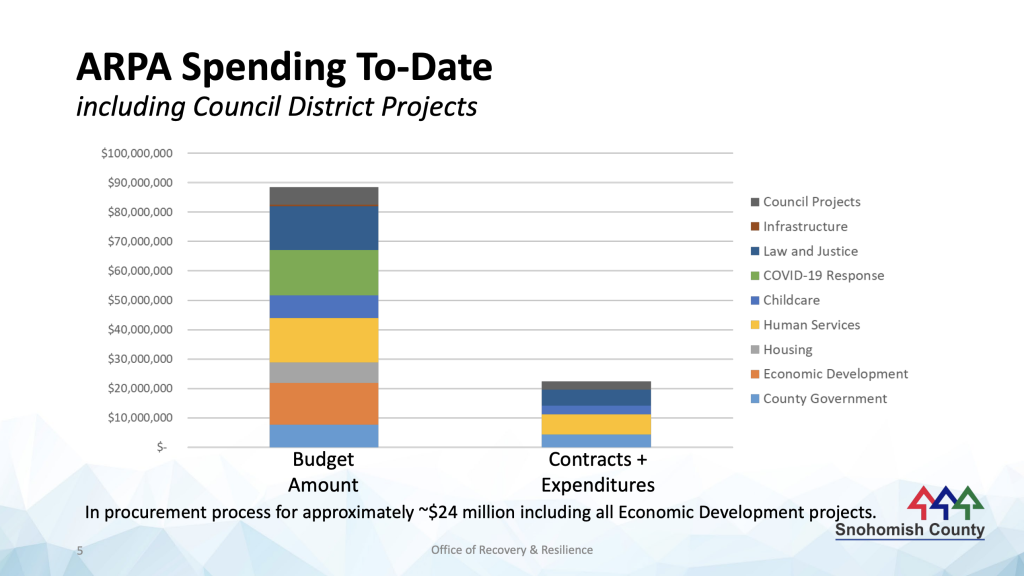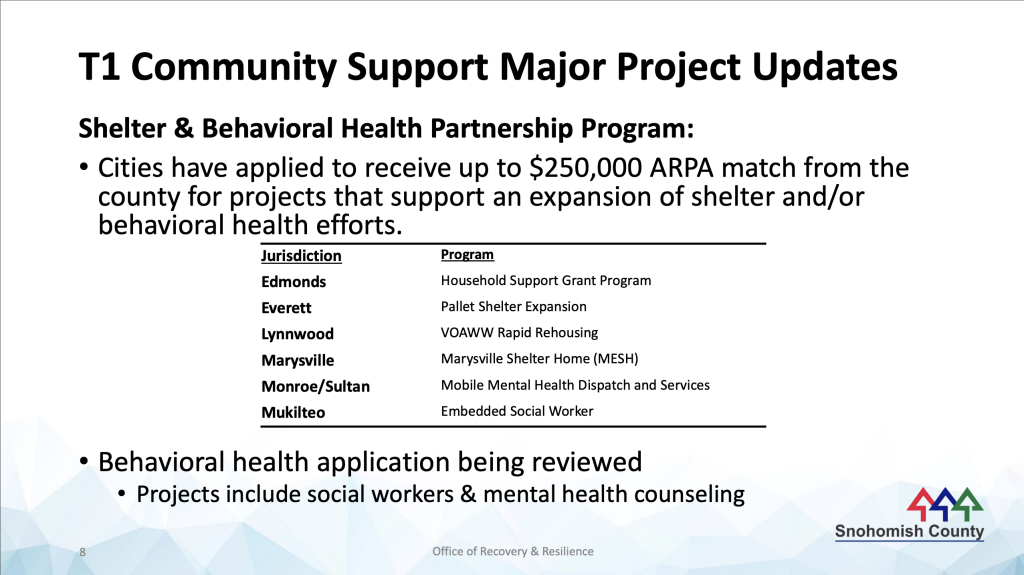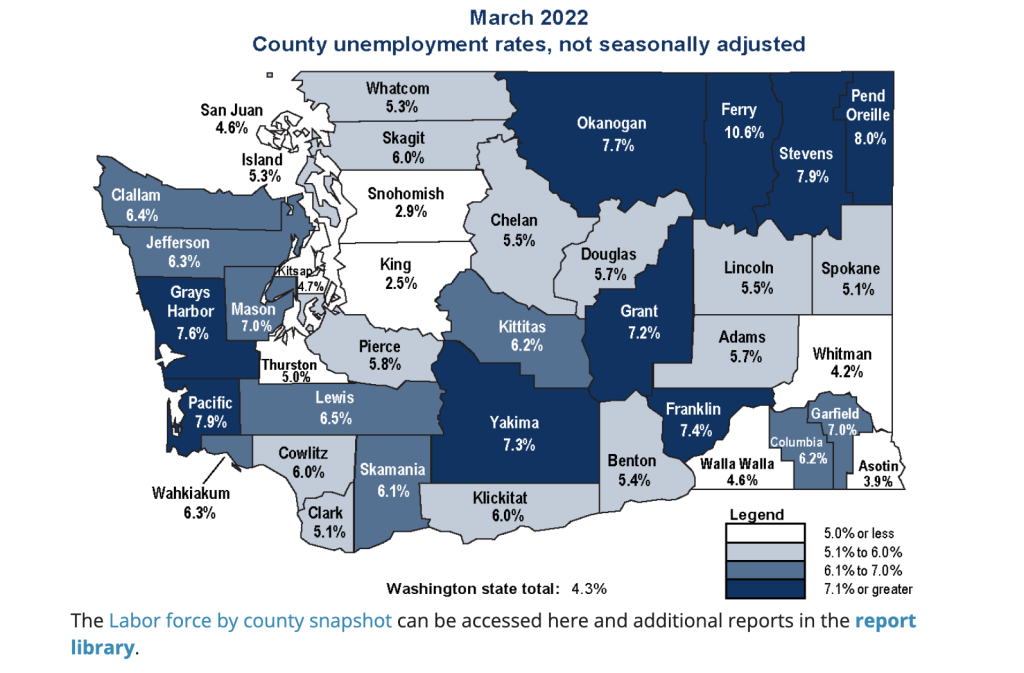EVERETT, Wash., May 17, 2022 – In the summer of 2021, Snohomish County Executive Dave Somers and County Councilmembers established the Office of Recovery and Resilience (ORR). The office’s mission is to guide the County in its efforts to recover from the pandemic and is funded to be operational through 2023.
One of ORR’s primary responsibilities is overseeing how the County allocates its American Rescue Plan Act (ARPA) funds and aims to administer said funds “quickly and equitably.” The County received $80 million in ARPA funds in May of 2021 and is expected to receive another $80 million between May and June of this year, totaling $160 million worth of ARPA funds.
“At ORR, our goal is to use these [ARPA] funds to make significant and sustainable positive changes for our families, workers, and small businesses, with a focus on communities most impacted by the pandemic,” explains ORR’s Deputy Communications Director Kelsey Nyland.
According to the National League of Cities (NLC), ARPA funds must be obligated (or contracted) by December 31, 2024, and any unexpended funds won’t be subject to recapture until the end of December 2026.
“We are working as hard and as quickly as we can to get this funding out and into the community and also to do it right so that the Federal government doesn’t come back later and say, ‘hey, we’d like that money back,’” says Chief Recovery and Resilience Officer for Snohomish County, Dr. Kara Main-Hester.
Office of Recovery and Resilience priorities
In Oct. 2021, the Exec. Somers and the Council passed a spending plan that allocated the first $80 million tranche into four main areas: Community Support, Economic & Workforce, Public Health, and Reserves & Operations.
Nearly $31 million went to Community Support—including childcare, youth and family support centers, and shelter for the houseless. Another $16.7 went to Economic & Workforce recovery—including programs that support small businesses. Public Health was allotted $11.5 million, specifically for COVID-19 response needs, while the remaining $19.6 million went to Reserves & Operations.
During the County Council’s May 4 General Legislative Session, Chief ORR Officer Main-Hester presented the specifics of how the ORR has used the ARPA funds so far.
For the first tranche, Dr. Main-Hester noted that some additional funding outside of ARPA has been budgeted for recovery, which is why the “Budget Amount” in the graph below displays a little more than $80 million. Of that amount, roughly $24 million has been contracted out or expended.

Community Support
In the Community Support category, Dr. Main-Hester highlighted how $500k has gone to the County’s Nourishing Neighborhoods program, which is a partnership between the County and local farmers that delivers food to families in need.
When the program first became operational in August 2020, it not only helped to fight food insecurity in the County but also helped farmers who had a surplus of food due to restaurant closures.
The ORR has also helped to allocate funds to shelter and housing efforts such as the New Start Center program, which will receive between $8 and $10 million. The program’s goal is to purchase a motel or hotel with ARPA funds to create around 150 new housing units.
The ORR enlisted the services of a broker in Nov. 2021 and has been looking at potential properties across South County and Everett.
Additionally, to address behavioral health and shelter needs, the ORR has offered to match cities for up to $250,000 of ARPA funds for programs that meet their specific needs. For example, the City of Everett is looking to expand its pallet shelters, while the City of Mukilteo seeks to boost its Embedded Social Worker program.

Economic and Workforce Development
The ORR’s Small Business Innovation Assistance program was developed in collaboration with small businesses and non-profits to discern what businesses need to be successful in the wake of COVID-19.
“I will tell you in our outreach,” Dr. Main-Hester said during her presentation to the Council, “the answer was not ‘small businesses just need cash.’ It’s ‘small businesses need assistance, but don’t necessarily have the time to do courses and navigate the system.”
The program offers two pathways of assistance, one for small businesses and one for start-ups; both focus on helping companies transition into online sales and delivery systems, creating customized recovery/support plans, and offering one-on-one counseling. The program also provides small grants to help businesses realize their plans.
Dr. Main-Hester relayed to Council how $5,000 is enough to make the difference for these businesses, explaining that “It makes their online platform more stable from a cyber security standpoint [and] allows them to have new registers for online ordering.”
The start-up pathway helps developing entrepreneurs connect with a cohort of fellow business owners and training courses and eventually brings them up to speed with the first pathway.
Eligibility for the Small Business Innovation Assistance program depends on which industries have been impacted the most by COVID-19, such as leisure, hospitality, and tourism, and which industries have experienced severe job losses, like Snohomish County manufacturing.
Recruiting for the $3 million program is projected to begin this summer, and the ORR will announce more details on the program later today.
The ORR is also partnering with IT and Public Works to study broadband access in the County and develop a plan to address infrastructure barriers, affordability issues, and lack of high-quality broadband. The study will take place during the summer and will help inform future policies and investments.
Allocating the second $80 million tranche
How the second half of the $160 million worth of ARPA funds will be spent is to be determined by the ORR through various partnerships around the County. “The goal is really to ensure that these investments are directly responsive to community needs,” said Dr. Main-Hester.
“And I will tell you, I started in Snohomish County in September. I had conversations with a variety of you, a variety of mayors—the needs in September are extremely different than the needs in May of 2022, particularly in our business world,” she continued. “We didn’t think we’d be talking about workforce issues, and we are.”
Dr. Main-Hester noted that the employment rate in the County is unexpectedly low. In fact, Snohomish County has the second lowest employment rate in the state at 2.9% as of March 2022, just behind King County’s 2.5%, according to the state’s Employment Security Department.

To quickly assess the greatest needs in the County, the ORR met with stakeholders and partners from Human Services organizations, faith communities, and workforce development, to name a few.
Aside from asking where the greatest needs are, the ORR sought solutions that have already proven to be successful. “To be quite honest, with one-time funding that needs to be spent fairly quickly, if we know of a solution that works, it’s much easier to implement a program for something that we already know of instead of creating something new,” Dr. Main-Hester explained.
From those conversations, the ORR determined the primary community needs, including accessible and affordable childcare, affordable housing, more behavioral health and human service workers, and addressing the impact two years of virtual schooling has had on students and their families.
“In all of these areas, when delivering services, it’s been very clear that we need to be culturally responsive and reaching out to communities who may not know how to reach us,” Dr. Main-Hester said.
Over the next couple of weeks, the ORR will continue to meet with mayors and tribal leaders across the county to further assess the needs and better understand where to allocate the remaining ARPA funds.
The ORR is also continuing to develop contracts for the first tranche—right now, with a focus on tourism marketing, Shelter Partnership programs, child care support, and job training.
To watch Dr. Main-Hester’s full presentation on the ORR’s activities, click here.









3 Responses